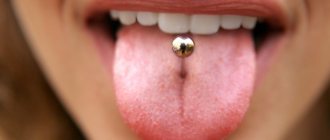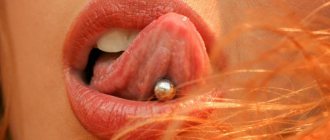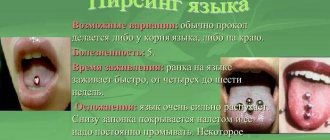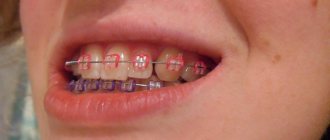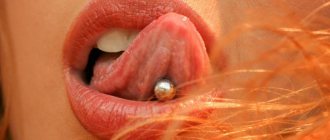Causes of infection after tongue piercing
From a medical point of view, piercing is a procedure associated with violating the integrity of the skin (invasive). And, like many other similar procedures, it can cause a variety of consequences. The following problems are typical for oral piercings:
- allergy to the material from which the jewelry is made, or to the drug that was used to treat the puncture site;
- formation of scars;
- chronic injury to teeth and mucous membranes;
- increased salivation (hypersalivation);
- development of infection and, as a consequence, inflammation [1].
Infection of a puncture site in the oral cavity occurs mainly for two reasons:
- After the procedure, the wound is not cared for or care is carried out incorrectly or irregularly.
- The biological balance in the oral cavity is disrupted due to the constant locally irritating effect of decoration.
In the oral cavity, a microbiome is formed and exists in a more or less constant quantitative and qualitative composition. This is a collection of microorganisms that normally (when there are no inflammations or other provoking factors) are in biological balance. This means that opportunistic microorganisms are not activated and do not lead to infection, because there are no prerequisites for this [2].
Only with the advent of molecular genetic research methods did the study of the biology of microorganisms (microbiome) truly begin as one of the leading triggers for the development and progression of inflammatory diseases of the dental system.
They inhabit the mucous membranes, the back of the tongue, the gingival sulcus, oral fluid and dental plaque, receiving the necessary proteins, carbohydrates, amino acids, inorganic and other substances from the oral fluid. Occupying only 0.03–0.05 m² of oral cavity area, the microbiome of this ecological niche includes representatives from 530 to 700 stable species. Katola V.M., Ph.D., leading researcher at the Institute of Geology and Environmental Management, Far Eastern Branch of the Russian Academy of Sciences [2]
Some microorganisms play a positive role in the health of the oral cavity, mucous membranes, and teeth. Thus, bifidobacteria, in the course of their life activity, help to increase local immunity in the mouth, suppress the development of pathogenic flora, and reduce the likelihood of developing caries. At the same time, streptococci, actinomycetes and other microorganisms increase the level of acids, which over time dissolve tooth enamel, which increases the sensitivity of teeth, decreases their mineral density (primarily due to the destruction of calcium and fluoride), and inflammation of periodontal tissues develops. which hold the tooth in the socket [2].
Tongue piercing as an injury and jewelry that is inserted into the hole changes the biochemical balance of the environment inside the oral cavity. The protective properties of saliva, the rate of its secretion and the activity of enzymes change, the hygienic condition of the oral cavity and teeth deteriorates, the mechanism of chewing and articulation changes. All this, in combination with other factors, leads to the creation of conditions under which “bad” bacteria, that is, opportunistic bacteria, multiply more actively. Microbes easily settle on the inflamed tissue at the puncture site, multiply and cause an infectious process. Most often, after tongue piercing, infection is associated with various pathogens: Actinomyces, Campylobacter, Neisseria, Streptococcus, Candida fungi and others [3, 4]
Rules for handling a pierced tongue
The long dumbbell can be replaced with a shorter dumbbell after at least ten days to avoid recurrence of tongue swelling. It is imperative to remove the formed plaque from the tongue and jewelry every day. A soft toothbrush is great for this. Cooled water, which it is advisable to drink every morning, will help reduce swelling on the tongue. In the first days after tongue piercing, you need to speak as little as possible, since unnecessary movements of the injured tongue and dumbbells can disturb the wound and cause bleeding from it.
To prevent swelling from increasing, during the healing period it is necessary to avoid spicy foods and hot liquid foods - soup, tea, coffee. Alcohol is also temporarily contraindicated.
It is also not recommended at the initial stages of healing to feel the dumbbell with the tip of your tongue and try to “play” with it - this will slow down the process of tissue regeneration and can provoke the formation of scars. It is also not recommended to remove the dumbbell, since the puncture of the tongue will heal very quickly and everything will have to be done anew. You should abstain from oral sex for at least fifteen days - kissing should also be postponed until the puncture is completely tightened.
Typical symptoms after piercing
Of course, not every piercing leads to infection, but some vigilance is needed. A tongue piercing is an injury, and it heals in the same stages as other injuries. This stage lasts, according to various sources, up to 10–14 days. Typical complaints and symptoms after piercing are:
- swelling;
- pain or discomfort in the puncture area;
- feeling of tightness, numbness of the tongue;
- tingling, burning, especially when food, drinks, or medications come into contact with the wound;
- discharge of a small amount of blood or yellowish serous fluid [1, 4].
Installed jewelry can be a factor of permanent trauma, and this leads to chronic low-grade inflammation, in which there is minor local swelling and slight redness due to disruption of the integrity of the epithelium.
Preparation for the procedure
To avoid the development of complications, it is important to know several points before starting the procedure:
- Select the first earring wisely: the alloy of the product should not oxidize. The first bar should be larger in size than the permanent one - this is due to the fact that after the puncture the tongue swells. When the canal heals and the swelling subsides, the temporary product is replaced with a smaller piece of jewelry. There should be no samples, engravings, or various patterns on the surface. If the bar is not smooth, the puncture channel takes longer to heal, as it is injured by the patterns. In this case, the healing period can be several months.
- Tongue treatment: during the operation, the specialist himself disinfects the puncture site. After the procedure, you will need a care product and rinse to rinse your mouth, which will be recommended by a specialist.
- Selecting a clinic and specialist: the main thing is health and safety, so it’s worth finding an experienced and trusted piercer. The place where the procedure is performed must be clean. A prerequisite for the operation of such establishments is the presence of a sterilization zone where disinfection equipment is located (trays, boxes, dry-heat ovens).
Possible signs of infection
If an infection is added to post-traumatic inflammation, local and general symptoms of infection occur. Their appearance is associated with a protective reaction at the local and general level of the body in response to chronic inflammation and changes in the microbial composition in the oral cavity. Accordingly, there are differences between local (in the oral cavity and on nearby tissues) and general manifestations of the infectious-inflammatory process associated with a cascade of reactions to the pathological process. These symptoms can appear at any time.
Local symptoms include:
- increased pain;
- the appearance of a twitching pain that can spread (give) to the ear, nose, submandibular area, and head;
- the tongue “tastes” hot, a change in its relief occurs;
- increased swelling;
- in the mirror you can see redness, sometimes whitish films, veins of blood vessels;
- the appearance of cloudy discharge, possibly with an unpleasant taste and odor [4].
General symptoms:
- increased body temperature;
- chills;
- body aches;
- decreased appetite;
- increased fatigue;
- enlargement of local lymph nodes (on the neck, on the back of the head, behind the ears) [4].
Keep the rest of your mouth clean
When it comes to tongue piercings, you need to do more than just clean the piercing. You should also keep the rest of your mouth clean.
This will help prevent bacteria from spreading from your mouth and getting inside your piercing.
Dental floss
Flossing helps remove food debris and plaque stuck between your teeth. If not removed, it can lead to bacterial overgrowth and gingivitis. Floss your teeth once a day.
Cleaning
Brushing your teeth twice a day is just as important as flossing. You can also brush your teeth at midday to prevent bacteria buildup. Toothpaste is unlikely to harm your tongue piercing, but be sure to wash it thoroughly.
Rinsing
If you haven't used mouthwash before, there's no need to start now.
If you are using mouthwash as usual, follow the directions for use. Avoid alcohol-based rinses.
How to prevent infection
There are many reasons for the development of infection after piercing, and they are not always associated with non-compliance with aseptic and antiseptic methods during puncture. But given the invasiveness of the procedure, you need to carefully choose a salon for piercing, focusing on the recommendations of Rospotrebnadzor. The main points of infection prevention are simple [5]:
- Do not carry out procedures during acute illness (colds, indigestion, herpes rashes, etc.) or during exacerbation of chronic diseases.
- Perform piercing only in a certified center, where the sterility of the instruments and the puncture process is maintained.
- Follow the recommendations for caring for the postoperative wound.
- Take regular and proper oral care [1, 4].
Lip piercing
Caring for a lip piercing has a lot in common with caring for a tongue piercing. It is also necessary to adhere to a diet, refrain from kissing and oral sex, and rinse the oral cavity with individually selected solutions of disinfectant liquids. The replacement of a long nail with a short one occurs in a similar way after the swelling subsides. But lip piercing requires additional attention: daily (preferably in the morning) the jewelry should be treated with saline solution, dissolving and removing the scab. After cleansing, the wound is lubricated with lavender oil, carefully turning the jewelry so that the oil gets inside. Healing usually takes about a month, sometimes complete healing can take up to eight weeks, which is absolutely normal. It is also normal for the jewelry to “nest”—move to the inside of the lip. Rings are more prone to this behavior than studs, as they are more mobile.
Non-dental infections after piercing
Like any injury, piercing reduces the body's defenses. At this time, dormant infections outside the oral cavity may become active and cause an acute process. If hygienic requirements, asepsis and antiseptics are not observed during piercing, there is a risk of contracting infections transmitted by “blood”, blood transfusion, when poorly treated instruments or hands, on which particles of infected blood of a sick visitor to the piercing salon remain, the infection enters the blood of a healthy one. This is how HIV, tetanus, and hepatitis are transmitted [1].
How to Identify and Treat a Tongue Piercing Infection
How infections develop
Infection occurs when bacteria gets inside the piercing. Tongue piercings—especially new ones—are more prone to infection than other piercings due to all the bacteria in the mouth. Most bacteria enter the body through food and drink. French kissing, oral sex, and other types of sexual activity can also carry bacteria.
Keep reading to learn how to identify an infection, relieve symptoms, and prevent further complications. Beauty salon enlarge individual parts of the tattoo.
How to identify an infection
If the piercing is new, irritation is normal.
During the first two weeks you may experience:
- Redness.
- Slight swelling.
- Light pulsation.
- Mild heat or warmth.
- Clear or white discharge.
Redness or swelling that extends beyond the piercing may be a sign of infection.
Other early signs of infection:
- Unpleasant swelling.
- Lasting warmth.
- Strong pain.
- Excessive bleeding.
- Pus or yellow discharge.
- A bump on the front or back of the piercing.
- Heat.
Mild infections can usually be treated at home. But if your symptoms are severe or if you are experiencing the infection for the first time. You should have your piercing examined immediately.
Non-infectious problems after piercing
Reactions to piercings are unpredictable and varied, but it is impossible to predict whether a particular patient will have them or not and what they will be. You should remember the risk of problems that are not related to the infectious-inflammatory process, but that affect the functioning of the dentofacial apparatus and the patient’s dental health. Piercing can provoke allergic reactions, periodontopathies, defects in hard dental tissues, tongue abscess, hypersalivation, impaired diction, galvanism, and scar formation [4].
Clean the area two to three times daily
Regular cleansing is the best way to get rid of bacteria and prevent further irritation. Morning and night cleaning are ideal. You can also rinse the puncture site with saline solution after each meal.
With pre-prepared saline solution
A ready-made saline solution is the easiest and most effective way to clean any piercing. You can buy them over-the-counter (OTC) at a piercing shop or local pharmacy.
To clean your piercing:
- Dampen a clean cloth or durable paper towel with the solution. Avoid using cotton balls, tissues, or thin towels as they may get caught in the jewelry and cause irritation to the piercing.
- Gently wipe the cloth or towel on each side of the jewelry. Do not rub or touch as this will cause irritation.
- Repeat this process as many times as needed. There should be no crust on the decoration or around the hole.
Treatment of an infected tongue
If you experience complaints similar to an infection, you should consult a doctor to diagnose the causes and determine treatment tactics. It consists of removing decorative piercings (sometimes replacing them with silicone ones), antiseptic treatment, and prescribing local and systemic antibiotics. If necessary, the wound is drained, sometimes surgical excision is performed, followed by closure of the defect. It must be remembered that chronic trauma to the tongue due to piercing can lead to malignancy—cancerous degeneration [4].
How is the procedure done?
Most basic piercings use special sterile instruments and piercing needles. A piercing gun with sterile attachments is used today only occasionally and exclusively for piercing the earlobe.
Before the piercing procedure, a consultation is always carried out; it is necessary to determine the puncture site, assess the anatomical features of the selected area and make a decision about the possibility of piercing in the chosen place. Contraindications for the procedure are identified.
Watch what you eat and drink until it heals completely
What you eat matters, especially if you have a wound in your mouth—in this case, an infected piercing.
Do
As your tongue piercing heals, focus on gentle products that are less likely to get on your jewelry.
It includes:
- ice cream
- mashed potatoes
- yogurt
- oatmeal
Anything chewy may require an extra salt rinse after eating. At this time, you should choose water. Tongue piercing tattoos of the body and face to enlarge individual parts.
Not to do
Extremely crunchy foods, such as chips, can cause additional pain and irritation. You should also avoid pepper, chili powder and other spices.
Alcohol can thin the blood and also damage the cells around the piercing. This may prolong healing time and increase the risk of complications of the body and face to increase certain parts of the beauty salon.
Coffee can also thin the blood. If you don't want to take a temporary break, reduce your usual intake until the infection goes away.
Pros and cons of piercings
One of the advantages of piercing is the ability to stand out, be stylish and special. The decoration is easily hidden and does not immediately catch the eye. In addition, it is possible to get rid of several kilograms, since the diet during the rehabilitation period is strictly limited.
The “disadvantages” of the procedure include the following:
- long wound healing, painful sensations;
- high probability of wound infection if the operation was performed independently or with non-sterile instruments;
- problems with gums and teeth due to inappropriate oral care.
It is worth considering that the development of such negative consequences as changes in taste sensitivity, severe bleeding, the appearance of speech defects, damage to tooth enamel, and numbness of the tongue is possible.
Tongue piercing is contraindicated for pregnant women due to the high risk of infection, for people with diabetes, and for people under 18 years of age.
Decorations
For standard primary tongue piercing decoration, barbells measuring 1.6mm x 18mm / 20mm or longer are used, made of titanium alloy, based on measuring the individual structure of the tongue, especially its thickness in a semi-relaxed state.
You can change to more comfortable short or ring-shaped jewelry a month after the procedure.
Piercing process
The structure and its features are different for everyone. The length, thickness, ridges and other external parameters of the tongue are taken into account when marking by your master. Classic piercing can be located along the physiological midline, and in its absence, its approximate location is chosen.
Often, a large and elongated hyoid frenulum, especially with a short tongue, can become a small problem.
It is worth knowing that in order to trim the frenulum you need to have medical indications for this procedure. Its removal should take place not only according to indications, but properly. Thus, the hyoid frenulum is responsible for the quality of your diction and the pronunciation of a number of voiced sounds, as well as correct physiological linguistic coordination. A piercing placed near the tip of the tongue with well-chosen jewelry will also look good.
In addition to the classic tongue piercing, you can choose other varieties in different planes: the tip of the tongue, the lateral (away from the sublingual veins) parts.
Your master should be well acquainted with the structure of the tongue so as not to damage the massive vessels passing through it.
How long does it take for an ear piercing to heal?
The punctured area is completely restored after 4-6 weeks. If more than a month and a half has passed and the healing of your ear piercing is still not complete, you should contact a specialist. But it’s worth considering that complete healing of a cartilage piercing takes much longer – about 5-8 months.
How long an ear piercing takes to heal depends on proper treatment of the skin with antiseptics. You need to rotate the earring every two days, otherwise it may grow on the young skin. It is recommended to use jewelry made of titanium, as it does not oxidize and does not cause allergic reactions.
Where can you pierce your tongue?
The earring should only be installed in a salon by a qualified technician.
It is very important that the piercer has all the necessary documents confirming the right to carry out such procedures.
Attempts to pierce the tongue at home can lead to irreversible consequences, including sepsis and tissue necrosis. Therefore, under no circumstances should you do a piercing at home, with friends. The lack of sterility and often the necessary skills on the part of the “master” is a direct path to complications after the procedure.
Note! A licensed piercer will never pierce the tongue of a minor child without parental consent. If the master is not interested in age, but immediately offers to start the procedure, this is a sign that he should not be trusted with your health.
Types of maxillary sinusotomy
There are classical (radical) maxillary sinusotomy and endoscopic maxillary sinusotomy.
Radical maxillary sinusotomy
The maxillary sinus operation is used to open the maxillary sinus through the mouth.
Radical maxillary sinusotomy is carried out using local or general (as indicated) anesthesia and includes the creation of access, excision of soft tissue, opening of the maxillary cavity and removal of polyps or foreign objects, formation of an anastomosis connecting the maxillary sinus with the lower nasal passage. The operation takes about an hour.
1 Radical maxillary sinusotomy in MedicCity
2 Radical maxillary sinusotomy in MedicCity
3 Radical maxillary sinusotomy in MedicCity
The essence of the operation
With an intraoral gairotomy, the otolaryngologist makes a horizontal incision in the soft tissues of the upper gum and moves them upward. Then, using special instruments, part of the bone plate on the facial wall of the maxillary sinus is removed. Thanks to the hole made, the sinus cavity becomes accessible for manipulation, and the otolaryngologist removes the pathological contents using a sharp spoon.
After scraping the mucous membrane, an anastomosis is formed with the nasal cavity, smoothing out the bone defect. A flap is made from the remaining free mucosa and placed on the bottom of the maxillary sinus to restore epithelization of its walls.
At the end of the operation, a tampon is placed in the sinus, which is removed into the nasal passage, and the wound on the side of the mouth is sutured. Using a tampon, sterility of the sinus is achieved and the accumulation of blood and pus is prevented.
After 48 hours, after preliminary anesthesia, the tampon is removed, and the patient is prescribed vasoconstrictor drops and sinus lavage. After a week, the sutures in the mouth are removed.
Endoscopic maxillary sinusotomy
Endoscopic maxillary sinusotomy is very popular as a minimally invasive and more gentle technique. With endoscopic maxillary sinusotomy, the lip is not dissected; the operation is performed through the nose. The procedure is virtually painless, characterized by minor swelling after surgery and does not leave scars.
Endoscopic maxillary sinusotomy. Its advantage over conventional surgery:
- low morbidity;
- minimal blood loss;
- the ability to perform surgery on an outpatient basis;
- quick rehabilitation period for the patient;
- absence of cosmetic defect after surgery.
The essence of endoscopic maxillary sinusotomy
This type of operation is performed under local anesthesia using special endoscopic equipment through the nose.
The indication for endoscopic maxillary sinus, as well as for conventional surgery, is a severe purulent process in the maxillary sinus, for which conservative treatment has proven ineffective.
The duration of endoscopic maxillary sinusotomy is 20 minutes. The opening of the maxillary cavity occurs through the nose, and not an incision is made, but a minimal puncture with a diameter of about 5 mm. An endoscopic tube is inserted into this incision, and foreign objects and pathogenic material are removed using suction. All manipulations are performed under the control of an endoscope.
The following methods of endoscopic access to the maxillary cavity exist:
- through the middle nasal meatus;
- through the lower nasal passage;
- through the anterior stack of the sinus;
- through the alveolus of the tooth (if there is a fistula);
- through the tubercle of the maxilla.
1 Diagnosis of sore throat
2 Diagnosis of sore throat
3 Diagnosis of sore throat
The use of endoscopic maxillary sinusotomy helps reduce trauma to surrounding tissues and speed up rehabilitation after surgery.
With the help of endoscopic maxillary sinusotomy, it is possible to avoid the feeling of numbness in the teeth on the operated side, which the patient experiences during a conventional operation.
Highly qualified otolaryngologists of the Multidisciplinary Clinic "MedicCity" will help you in solving various ENT problems. We possess all modern methods of diagnosing and treating diseases of the ear, nose and throat.
Showroom price
The cost depends on the status and pricing policy of the place where the piercing will be performed. It's better not to choose the cheapest offers. Having your tongue pierced in a decent piercing and tattoo salon will cost at least 2000-3000 thousand rubles. In a beauty clinic, the cost starts from 6,000 rubles.
Whether it is necessary to pierce the tongue, everyone decides individually. You shouldn’t chase fashion or try to prove something to those around you. This type of body modification is very controversial and specific. It won't suit everyone.
Before you pierce your tongue, you should consider all the pros and cons of this step.
What to Avoid While Your Tongue Heals
What to avoid:
- Hard, sour, sticky, spicy foods.
- Talk too much.
- Kissing and any other use of the mouth with girlfriends/friends
- Putting foreign objects in your mouth.
- Smoking (it’s better to abstain at first, and once the piercing heals, then quit smoking altogether)
- Experiment with tongue decoration (you will have plenty of time for this after healing)
The swelling should go down in a couple of weeks, but the healing period may take longer.
Once pierced, the tongue usually takes three to four weeks to completely heal. This is one of the fastest-healing piercings as the enzymes in saliva help fight infection and kill bacteria.
This is interesting: How to care for your tongue ring
You will need to use a good non-alcoholic mouthwash to help clean your mouth, but be careful not to over-clean, which can cause your tongue to turn green or brown. If this happens, simply reduce the amount of mouthwash you use and how often you use it.
- Days 1-5: After the first day, you will experience bloating. This will be worse during the first five days, when your speech will be impaired and you may have to change your diet to mashed potatoes, noodles, and other soft foods. Drinking cold drinks helps. For faster healing, you should avoid drinking alcohol or hot drinks, smoking, kissing, fiddling with or even touching a barbell, and ibuprofen and aspirin (which can increase swelling—use Tylenol instead).
- Days 5-7: The swelling will begin to decrease. Some people recover faster than others.
- Days 7-10: Swelling should go down now. When this happens, you need to have the bar replaced with a shorter one. The day you can replace the long barbell with a shorter one will depend on the amount of swelling you experience.
- Day 10-28: It may take 3 to 4 weeks to heal completely.
When can I remove the jewelry from my tongue and for how long?
The answer to this question varies from person to person. Tongues heal quickly, and even if the piercing is technically healed, it will also heal and close if you leave the jewelry out for an extended period. Some piercings can heal closed almost immediately in a day or two, while others with established piercings say they can go without jewelry for up to three weeks, don't worry.
This is interesting: Long list of navel piercing problems
How long does it take for a nose piercing to heal?
If proper care is followed, a nose piercing will take 4 to 10 weeks to heal. However, it is possible to remove the jewelry without harm or risk of infection only after six months.
Redness and ichor discharge persist for about two weeks. Regular treatment with Chlorhexedine, Miramistin and other means prescribed by the specialist will help speed up the process. To ensure that disinfectants get not only on the surface, but also inside the puncture, you need to slightly twist the earring.
Contraindications and possible consequences - can everyone have their tongue pierced?
Despite its wide popularity, piercing of this part of the body is not accessible to everyone. There is a whole list of contraindications that prohibit intentional injury to an organ:
- inability to take the healing period seriously: you should not get a piercing if you currently do not have the time and suitable conditions to regularly treat the wound, rinse and wash,
- pregnancy period: during this period, the risk of critical infection poses a truly serious threat, so it is simply unreasonable to expose yourself and the child to danger once again,
- allergy to antibiotics: in this case, the potential complication of infection can be fatal,
- allergy to metals,
- poor blood clotting,
- mental illness,
- epilepsy,
- oral diseases,
- autoimmune diseases, hemophilia, diabetes mellitus - all these are strict contraindications to intentional damage to the oral mucosa. If you have any health problems, it would be a good idea to consult your doctor.
Important! In Russia, piercing is allowed for persons who have reached the age of majority - 18 years. In some cases, it is possible to carry out the procedure from the age of 16, but only with the written official consent of the parents1.
Tongue diseases can cause poor wound healing
In addition to many contraindications, tongue piercing has a number of serious complications. Of course, today in medical centers and decent salons all risks are reduced to a minimum, but the likelihood of encountering a serious problem still remains. So, an infection can penetrate into the wound or the metal can provoke an allergic reaction. If the technician performs inept actions, bleeding may occur or a nerve may be damaged, which will lead to partial loss of sensitivity. The most dangerous possible consequence is infection through instruments - hepatitis, HIV and other dangerous diseases.
